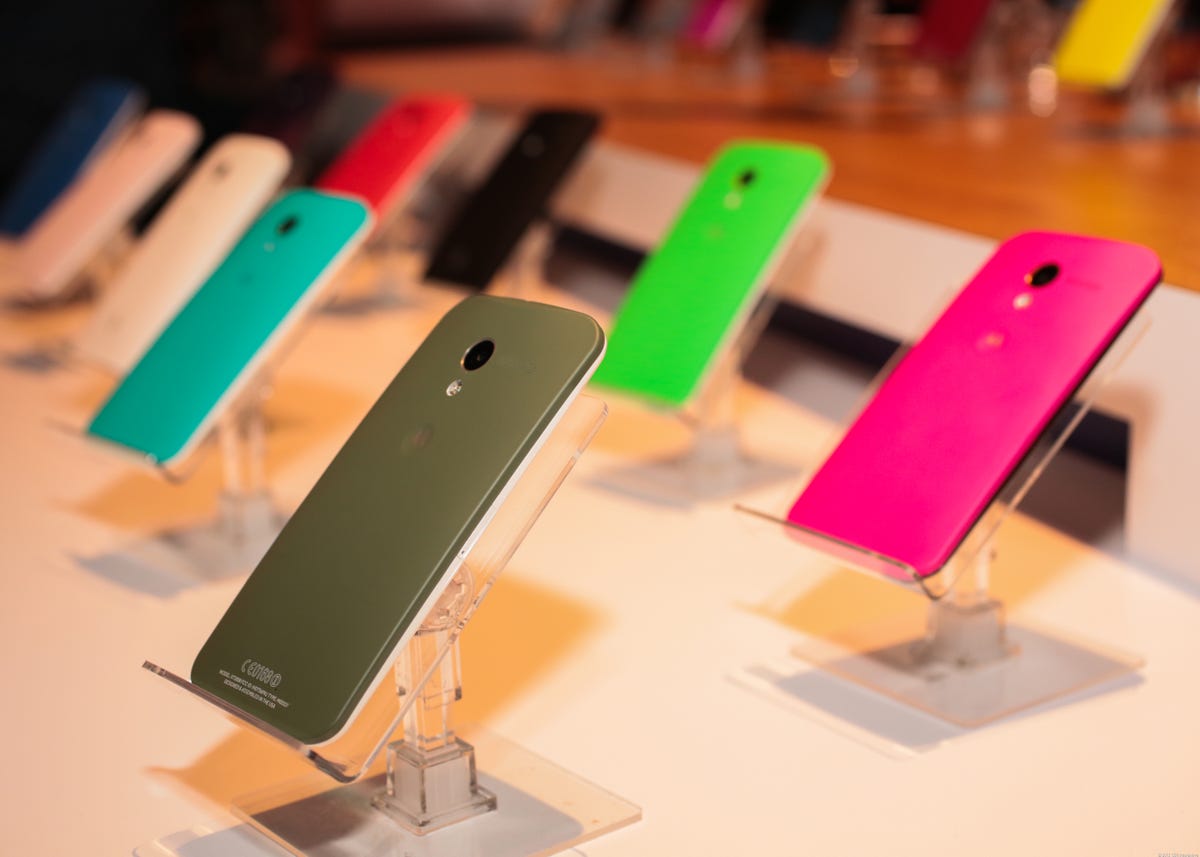The iPhone 5 may have found its polar opposite in Moto X.
For better or worse, Moto X — which was unveiled Thursday — is everything the iPhone is not. Rather than a tightly controlled look and feel for the device, Motorola will let customers tweak the colors and materials. Instead of the latest specifications, Moto X employs a solid — but not cutting-edge — set of hardware features. Instead of a proprietary operating system built for one device, it runs on an open platform available to hundreds of other phones.
“This is the blueprint for where Motorola and Google are going to go from here,” said Ramon Llamas, an analyst at IDC.
While Moto X can be considered the anti-iPhone, it is not is an “iPhone killer.” Despite the gratuitous use of that title over the last few years, the iPhone has not been felled by any device, and Motorola’s latest won’t be that lucky phone.
All about the Moto X
- Moto X: Magical features aimed to please everyone (hands-on)
- Moto X: The first true anti-iPhone
- Motorola’s flagship phone, the Moto X has arrived
- Comparing Motorola’s Moto X to Samsung’s Galaxy S4
- Meet the might Moto X (pictures)
But Moto X is an illustration of the contrasting philosophies between Apple and Google. Where Apple is about a single experience and polished products, Google is more about throwing things against the wall to see where they stick. With Moto X, Google and Motorola are giving consumers more control. Whether consumers want that control remains to be seen.
Regardless, interest in the device has been rabid ahead of its unveiling, which happened at an event in New York today. Following months of teases and leaks, Motorola confirmed that consumers would be able to customize the back, edge, and wallpaper for their device. Motorola is even testing different materials such as wood and bamboo for the back cover.
“It’s a great hook,” Llamas said. “When people are looking at phones, it’s hardware and aesthetics that get people first.”
The success or failure of Moto X will go a long way in determining just which philosophy is correct. While critics rail against the draconian measures Apple employs to ensure a slick iPhone experience, the franchise continues to be a blockbuster hit for the company. Conversely, will people want to sacrifice cutting-edge specs for a device adorned with their favorite colors?
If nothing else, Moto X represents a wholly different take on the smartphone. The industry has focused on bigger screens, faster processors, and unique features. But for the most part, there is a universal take-it-or-leave-it approach to the device. Just like with the iPhone, Samsung Electronics offers a single flagship Galaxy S4, while HTC has its HTC One.
Meet the mighty Moto X (pictures)






+22 more
Of course, both companies have branched out with variants of each device, such as the Galaxy S4 Active or HTC One Mini, but the manufacturers, and not the consumers, dictate the look of the devices.
Moto X’s customization options change the paradigm on how phones are made and sold to consumers, giving them another way of thinking about their mobile device.
Sadly, one rumor that turned out to be false was a lower price tag; the Moto X costs $199 with a two-year contract, which is standard for any decent smartphone.
Gartner analyst Carolina Milanesi, however, believes the Moto X’s customizable look is less important than its position as Google’s true flagship device. While the Nexus program will continue, she believes Moto X will be where Google’s hardware ambitions lie.
“Moto X is where Google thinks smartphones need to go in order to be instrumental in creating a higher stickiness to the ecosystem,” she said.


Sarah Tew/CNET
Motorola hopes this is the start of something. With the next version of Moto X, the company could start offering customized components — different processors, screen size, memory, and more — giving even more control to the consumer. Whether that’s feasible or even desirable remains to be seen, but it would be a natural evolution to what the company is starting with Moto X.
Motorola could certainly use a shot in the arm. It has been a financial burden to Google, which acquired the handset business last year. In the second quarter of this year, it lost $342 million, weighing down Google’s significantly more substantial profits.
Motorola has one solid ally in Verizon Wireless, which confirmed to CNET last week that Motorola was now the exclusive supplier of Droid smartphones. But Motorola’s presence at the other carriers has been weak, and it still lacks a product with universal appeal and availability like the iPhone or Galaxy S4.
Fortunately, the Moto X will be available on every major carrier — including Verizon — mimicking the strategy used by Apple, Samsung, and HTC.
Motorola hopes Google’s marketing heft and its customizable approach turn Moto X into the company’s first legitimate cross-carrier hit since the original ultra-slim Razr flip phone.
At least with Moto X, Motorola is trying something different. At a time when other vendors are rushing out high-end flagship devices that focus on specs, Motorola’s approach is refreshing.


Now playing:
Watch this:
Meet Motorola’s new Moto X
4:26



